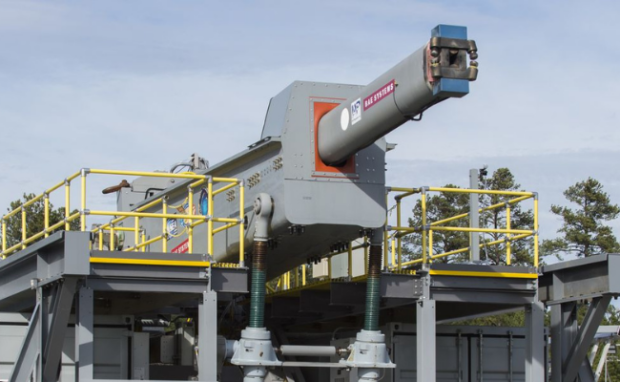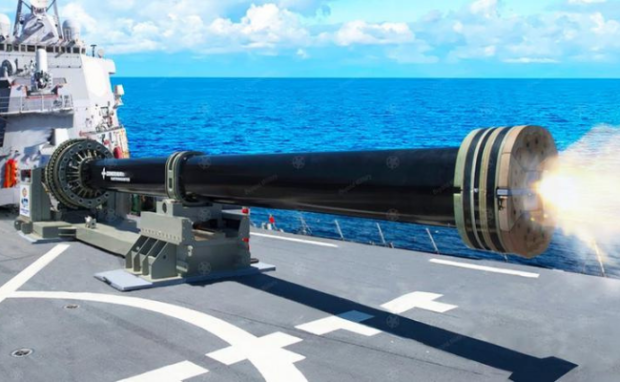Japan first to fire railgun from offshore vessel
Japan’s Ministry of Defense made maritime history by firing the first railgun from a battleship. Its Acquisition Technology & Logistics Agency (ATLA) tested it alongside the Japanese Maritime Self-Defense Force (JMSDF). The Eurasian Times says it can fire projectiles that travel roughly 2,230 m/s (Mach 6.5), almost seven times the speed of sound.
It seems the military is also transforming rapidly due to technological innovations. Nowadays, modern warfare involves drones and AI systems, so seeing armed forces test electromagnetic launchers isn’t surprising. However, many of these tools eventually improve civilian tools and services. For example, railgun tech could improve rocket launches.
This article will cover the history of railgun technology, and then it will elaborate on Japan’s latest. Later, I will discuss another country working on a similar technology.
How do railguns work?

A railgun uses electromagnetic energy to fire projectiles. As the name suggests, it has a power supply, armature, and rails. Here’s how each component works:
- The power supply delivers energy to the positive end of the rails.
- Rails have a positive and negative end. A projectile starts from the positive side, moves toward the armature, and exits at the negative end.
- The armature bridges the gap between the two rails and lets the current flow to the negative end and return to the power supply.
You may also like: Eco-friendly robot arm dismantles ships
Interesting Engineering says French inventor André Louis Octave Fauchon-Villeplée was the first to conceptualize the electromagnetic railgun. Later, German engineer Joachim Hänsler proposed the first railgun for shooting down warplanes.
The United States eventually realized Hänsler’s concept with its $500 million railgun project, but the Navy discontinued it. Nowadays, Japan and China have been showing their working prototypes.
How does Japan’s railgun work?
The Navy Recognition website said the country hasn’t disclosed exact details about its railgun test. Yet, the ATLA shared video footage of the railgun firing from various angles, showcasing its readiness.
In 2023, Japan unveiled its medium-sized electromagnetic railgun prototype. The weapon fires 40mm steel projectiles weighing 320g that accelerate at approximately 2,230 m/s or Mach 6.5.
The current version uses five megajoules (MJ) of charge energy, but ATLA will upgrade to 20 MJ for better performance. Navy Recognition says it can intercept aerial threats at sea, such as hypersonic cruise missiles.
ATLA plans to employ land-based railgun systems to target hypersonic missiles. Japan pursues this innovation in response to ramping threats from North Korea and China.
How does China’s Gauss cannon work?

In August, China tested a similar weapon called a Gauss cannon. It works like a railgun but uses a solenoid instead of rails. A solenoid is a wire coil that uses electromagnetic energy to propel objects.
One advantage a coilgun or Gauss cannon has over a railgun is the projectile doesn’t touch the barrel. As a result, you can prevent the weapon from overheating quickly and avoid friction from reducing projectile speed.
South China Morning Post reported China’s electromagnetic launcher accelerated a 124 kg projectile to 700 kph or roughly 434.96 mph. In contrast, Japan’s railgun propelled a 320g projectile to 2,230 mph or roughly 2,236.9 kph.
You may also like: Honkai: Star Rail was developed with AI
Naval University of Engineering Professor Guan Xiaocun believes in the potential of China’s Gauss cannon. “It has the potential for revolutionary breakthroughs in speed, range, power, accuracy, safety, flexibility, and reliability. It is widely applicable in areas such as weapon systems, near-earth satellites, and high-speed missile launches,” he said.
Conclusion
Japan recently unveiled its new railgun weapon firing on an offshore vessel. Soon, it could become a new line of defense against impending foreign threats.
However, Navy Recognition says the project still must overcome numerous limitations to become a viable military weapon. For example, it must resist corrosive saltwater, constant shocks, and extreme heat and cold.
Nevertheless, Japan, China, and other armed forces will continue to improve their might with new innovations. Learn more about those and other digital trends at Inquirer Tech.